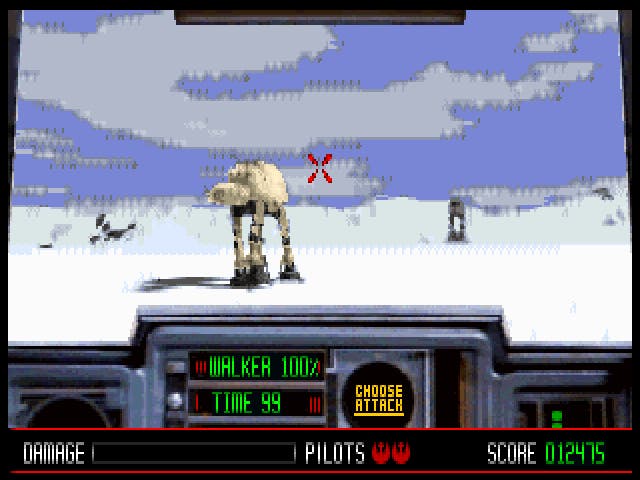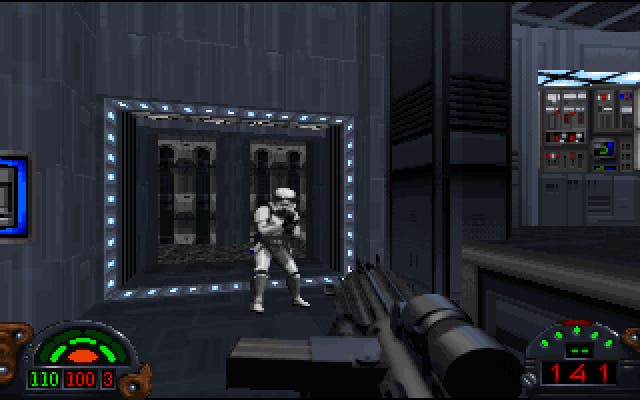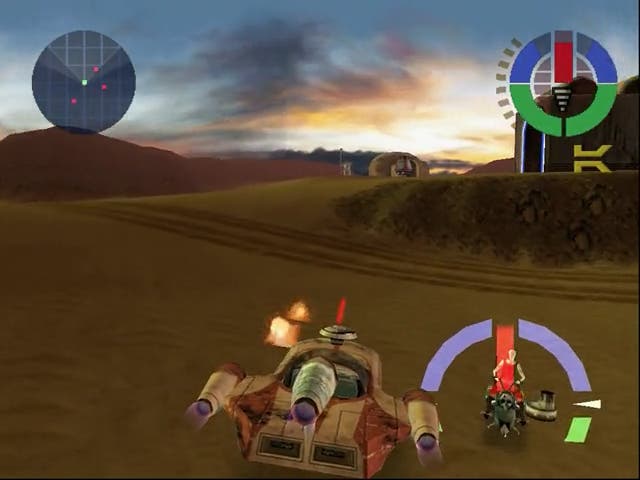A Force aside: Eight notable Star Wars spin-offs
Going Rogue.
When it comes to licensing and promotion, George Lucas has never been shy. After completing Star Wars: A New Hope in 1977, the writer/director spent considerable time and effort fine-tuning the subsequent marketing assault. Toys, books, lunchboxes and an R2-D2 spatula all appeared, some of them taking a side-step away from the main characters of the movies, creating their own stories, heroes and villains; some of them taking those familiar characters and putting them in unfamiliar settings.
Now, almost 40 years since the release of A New Hope, we finally have a cinematic Star Wars spin-off in Rogue One. Video games have long retained this tradition; the Star Wars universe contains such scope for extracurricular adventures, that it would have seemed churlish not to explore them. And explore them developers have, bolting on the characters from the sci-fi epic to whatever type of game they could label, package, promote and sell, usually creating new characters and worlds in the process. Here's some of the best - and worst - of Star Wars spin-off games from history.
Star Wars: Droids (1988)
shout>Platforms: Amstrad, ZX Spectrum, Commodore 64

Star Wars: Droids has the distinguished honour of being a spin-off of a spin-off. Aired on Saturday mornings between 1985 and 1986 (plus latter repeats in the UK), the cartoon occupied that void left by the temporary end of the series with Return Of The Jedi in 1983, and The Phantom Menace some 16 years later. The cartoon itself was average; the videogame based on it, licensed by UK budget powerhouse Mastertronic, was lamentable.
As the name suggests, the game stars that irascible duo, C3P0 and R2D2 in an adventure set just before A New Hope. Having been kidnapped by an unpleasant gang, the pair must escape through a series of tunnels, avoiding traps and enemy robots. There are two major issues with Star Wars: Droids. First of all, the formerly peace-loving 3P0 is now a destruction-wielding bastard, flinging deadly bombs at enemies, while the designers saw fit to utilize a bizarre icon-driven control method that renders the game virtually unplayable. Even for the low price of £2.99, it's hard to imagine many Spectrum, Amstrad or Commodore 64 owners being particularly chuffed with this back in 1988, despite the famous characters.
Rebel Assault (1993)
Platforms: PC, Mega CD

With different characters thrust into roles that echoed their movie counterparts, Rebel Assault skipped vaguely alongside the plot of A New Hope, while introducing the occasional new planet to mix things up. Starting off with a training mission on the familiar scene of Tatooine, the player takes control of Rookie One, A Luke Skywalker-esque ingénue learning the ropes and yearning to join the rebellion. Soon Rookie One is jetting into outer space, taking on Star Destroyers, TIE Fighters and, ultimately, the Death Star itself.
Time has not been kind to Rebel Assault. A product of an era where CD-ROMs were beginning to find a foothold as a medium, its limited FMV on-rails blasting action seems laughably limited by today's standards. Iconic segments such as assaulting AT-ATs on Hoth are relegated to boring fly-bys, punctuated by the odd bit of targeting and shooting against a leg or head. Yet viewed with an early-90s perspective, Rebel Assault was a dramatic shift from the Nintendo platform jumping games that the series had until then specialised in. Now players could hop into an X-Wing and take on the Empire, accompanied crucially, by the famous John Williams score. As for Rookie One? He probably met an untimely death back in Beggar's Canyon, trying to control his unwieldy T-16 Skyhopper.
See also: Rebel Assault 2: The Hidden Empire (PC, PlayStation)
Dark Forces (1995)
Platforms: PC, PlayStation

The original Dark Forces, inspired by the success of Doom, introduced fans to Kyle Katarn, former Imperial officer turned mercenary, hired by the rebels in a story set just prior to A New Hope. The game's obligatory pre-game crawl reveals some interesting information; described as a 'rogue', Katarn's first mission is to infiltrate an Imperial base and pilfer - you guessed it - the Empire's Death Star plans. That done, Katarn is given more tasks by the rebels, chiefly investigating and eliminating the Empire's Dark Trooper program, cybernetic super soldiers laden with superior weapons and armour.
Like most of these spin-offs, Dark Forces included familiar locations from the movies, although technology of the time limited the appearance of the iconic vehicles. There was Stormtrooper blasting abound, however, and huge fun to be had in wandering the atmospheric levels. The engine itself was hugely improved over Doom; Katarn could jump, look up and down and a then-complex map of rooms-over-rooms was employed. Dark Forces' sequel, Jedi Knight, saw Katarn fully inducted into the rebellion and as the name suggests, becoming a Jedi himself. But for almost 21 years, he was the man who stole the Death Star plans.
See also: Dark Forces 2: Jedi Knight (1997)
Star Wars Monopoly (1997)
Platforms: PC
Published under licence by Hasbro, Star Wars Monopoly, as the name clearly suggested, was the classic trading game updated with Star Wars characters and locations. The board game (unlike its recent iteration) followed the original's template closely; gone are Old Kent Road, Vine Street and Mayfair; in come Lars Homestead, Dagobah Swamp and Imperial Palace, Coruscant. Houses and hotels are replaced with colonies and starports, and there are new utilities, too, such as the moisture farm, plus chance cards are replaced by bounty tasks.
The videogame version was released in 1997 by Hasbro's Interactive label, and is good fun for any budding entrepreneur with even a passing interest in Star Wars. The player pieces are famous characters from the movies, and they dash nimbly across the board, the determining dice roll primed by laser fire from the Millennium Falcon or another space vehicle. Clips from the movie punctuate the action, as do occasional TIE Fighter/X-Wing battles, and overall it's a decent stab at an interactive board game, albeit one that's likely to go on for a long, long time and end up in a family argument. Sorry about the mess.
See also: Star Wars Chess (1993)
Masters Of Teras Kasi (1998)
Platforms: PlayStation

This is it. The big one, the one everybody remembers. You know - the shit one. But hard as it may be to imagine, back in 1998, Masters Of Teras Kasi was a huge deal. After all, its USP was simple and alluring: a one-on-one beat-'em up with Star Wars characters. Boba Fett slugging it out with Han Solo? A Gamorrean Guard pigging it out with a Tusken Raider? "It's an idea so good, so bloody obvious, that it simply had to happen," ran an effusive preview in the Feb '98 issue of PlayStation Power magazine. The chance to play your heroes in a new scenario was as appealing as the authentic backgrounds and music. So what went wrong?
Well, quite a lot as it transpired. After a functional plot is revealed via the traditional screen crawl - it's post-A New Hope and the Empire has hired some mysterious woman called Arden Lyn to take on the Rebels in the art of Teras Kasi - the set-up and design of the game looks fine. But the meat and bones of any fighting game, the moves, are unimaginative and just plain silly. Characters such as Darth Vader and Luke Skywalker wield lightsabers, and in theory should have been vastly superior to the likes of a ragged Tusken Raider. But the game's balancing system negated the potential excitement of removing an opponent's limbs one by one, reducing the great Skywalkers to limp fighting moves and feeble jumps.
It all leaves you with a bad feeling; maybe it just wasn't that good an idea to start off with.
See also: The Force Unleashed II (PC, PlayStation 3, Xbox 360)
Knights Of The Old Republic (2003)
Platforms: PC, Xbox
The new trilogy, while maligned, did at least create the opportunity for some excellent spin-off adventures, of which one of the finest was Bioware's Knights Of The Old Republic. While in terms of gameplay it represented a three-quarters step between the developer's famous RPGs of olde and its modern epics such as Mass Effect, KOTOR's setting (four thousand years prior to the Star Wars movies) and superb atmosphere made it an instant classic.
Yet, despite it being set a really long, long, long, long, long time ago, KOTOR's plot is not so dissimilar to A Phantom Menace, only without the annoying little kid. Once more the Jedi are in league with the Republic, resisting the growing Sith menace. Taking on the role of a Republic soldier, the player must train in the Jedi arts before an inevitable final confrontation with evil Sith lord Darth Malak. And there are plenty of traditional Star Wars locations along the way; it may be four thousand years earlier, but Tatooine is still a shithole.
See also: Knights Of The Old Republic II: The Sith Lords (PC, Xbox)
Star Wars: Demolition (2000)
Platforms: Dreamcast, PlayStation

Up until this game, Star Wars' famous vehicles had gone largely unused in the majority of its ground-based games. Sure, you got to fly an X-Wing in, erm, X-Wing, but an AT-ST? Or Landspeeder? Then, in 1998, Activision released Vigilante 8, a vehicular combat game based in spirit on the Seventies funk-a-thon Interstate '76. When Phantom Menace stunned audiences everywhere in 1999, it seemed a good opportunity to take Vigilante 8's template and reskin it with the Star Wars IP. And, in contrast to Teras Kasi, the idea actually worked.
Star Wars: Demolition is initially based on Tatooine where crime lord Jabba The Hutt (pre-strangulation, naturally) has decided to host a series of arena-based battles with the winner netting a million credits, or something. Like the infamous beat-'em-up, this resulted in a series of incongruous battles (AT-ST versus Boba Fett, Landspeeder versus droid from Episode 1, and so on) but crucially was actually fun, thanks to the previous experience of developer Luxoflux. Limited maybe, but fun. And you got to mess around as the gruesome Rancor, stomping on Jawas and taking out enemies with your stinky breath. Bliss.
See also: X-Wing Alliance (PC)
Star Wars: Bounty Hunter (2002)
Platforms: GameCube, PlayStation 2
There's no doubting that one of Star Wars' most popular characters is the grizzled 'hope I'm getting paid for this' Boba Fett. Considering his brief appearance in episodes V and VI, it's all a bit bizarre, but maybe not considering that, essentially, bounty hunters are really cool, or at least they are in Star Wars. Lucasarts took this idea, but not the obvious character choice, and shoehorned it into a game focused on Jango Fett, earning his stripes in the titular role, prior to life as a blueprint for a billion ruthless clones.
It's the aftermath of the Battle Of Naboo, and in the ensuing chaos, a nasty gang called the Bando Gora have begun to cause trouble throughout the galaxy. It's up to Jango to prove his worth, and also dispose of a bunch of scum and villainy in the process. Star Wars: Bounty Hunter helpfully plugs the gap between episodes I and II, explaining how and why Jango became the basis for the clone army. His jet pack, cutting tool, twin blasters and other gadgets are all incorporated into the sleek, if somewhat average gameplay. But a spin-off movie starring his infamous offspring Boba Fett, you say? Now there's an idea...
See also: Republic Commando (PC, Xbox)









